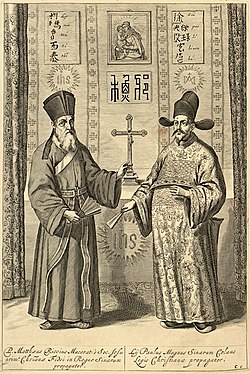Inculturation after the discoveries
After the discoveries of new territories and the Council of Trent (1545–1563), the inculturation movement became more systematic and was particularly associated with the Jesuits. The Catholic Church had to ponder how and to evaluate elements of ancient non-Christian cultures. Notable figures were, among others, the Jesuits José de Anchieta for the indigenous people of Brazil, Thomas Stephens in Goa, Roberto de Nobili in Southern India, and Alexandre de Rhodes in Vietnam.
China

The Jesuits Matteo Ricci (from Portugal), Adam Schall von Bell and others were missionaries appointed to introduce Christianity to China. They learned Chinese and more about the culture, seeking to find ways to help the people understand elements of the Gospel. Ricci and Schall were appointed by the Chinese Emperor in Peking to be court mathematicians, court astronomers and Mandarins. The first Catholic Church was built in Peking in 1650. [9] The emperor granted freedom of religion to Catholics.
Ricci had adapted the Catholic faith to Chinese thinking, permitting, among other things, the cultic veneration of ancestors, which he described as cultural practice. The Holy See disagreed, deeming the veneration an act of worship and hence idolatry. It forbade any adaptation of Christianity in the so-called Chinese Rites controversy in 1692 and 1742. The Chinese emperor felt duped and refused to permit any alteration of existing Christian practices. The Church suffered setbacks in 1721 when the Kangxi Emperor outlawed Christian missions. [10] According to Franzen, "The Vatican policy was the death of the missions in China." [11]